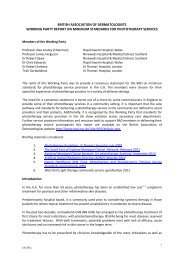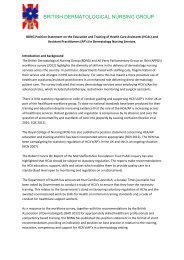Improving outcomes for people with skin tumours including melanoma
Improving outcomes for people with skin tumours including melanoma
Improving outcomes for people with skin tumours including melanoma
Create successful ePaper yourself
Turn your PDF publications into a flip-book with our unique Google optimized e-Paper software.
<strong>Improving</strong> Outcomes <strong>for</strong><br />
People <strong>with</strong> Skin Tumours<br />
<strong>including</strong> Melanoma<br />
Appendix 6<br />
Randomised controlled trial (RCT)<br />
A type of experiment that is used to compare the effectiveness of<br />
different treatments. The crucial feature of this <strong>for</strong>m of trial is that<br />
patients are assigned at random to groups that receive either the<br />
interventions being assessed or control treatments. RCTs offer the<br />
most reliable (i.e. least biased) <strong>for</strong>m of evidence of effectiveness.<br />
Retinoid<br />
Vitamin A or a vitamin A-like compound.<br />
Sarcoma<br />
A cancer of the bone, cartilage, fat, muscle, blood vessels, or other<br />
connective or supportive tissue.<br />
Scintigraphy<br />
A diagnostic method. A radioactive tracer is injected into the body.<br />
The radiation it sends out produces flashes of light on a scintillator<br />
(instrument used to detect radioactivity), and they are recorded. Also<br />
called radionuclide scanning.<br />
A6<br />
Sentinel (lymph) node biopsy<br />
Removal and examination of the sentinel node(s) (the first lymph<br />
node(s) to which cancer cells are likely to spread from a primary<br />
tumour). To identify the sentinel lymph node(s), the surgeon injects a<br />
radioactive substance or blue dye, or both, near the tumour. The<br />
surgeon then uses a scanner to find the sentinel lymph node(s)<br />
containing the radioactive substance or looks <strong>for</strong> the lymph node(s)<br />
stained <strong>with</strong> dye. The surgeon then removes the sentinel node(s) to<br />
check <strong>for</strong> the presence of cancer cells.<br />
Sézary syndrome<br />
A <strong>for</strong>m of cutaneous T-cell lymphoma.<br />
Squamous cell carcinoma<br />
Cancer that begins in squamous cells. Squamous cells are found in<br />
the tissue that <strong>for</strong>ms the surface of the <strong>skin</strong>, the lining of the hollow<br />
organs of the body, and the passages of the respiratory and digestive<br />
tracts. Also called epidermoid carcinoma.<br />
Supportive care<br />
Care that helps the patient and his or her family and carers to cope<br />
<strong>with</strong> cancer and its treatment, and in the case of the family and<br />
carers, <strong>with</strong> bereavement. It aims to help the patient maximise the<br />
benefits of treatment and to provide the best possible quality of life.<br />
Surgical oncologist<br />
A doctor who specialises in using surgery to treat cancer.<br />
Synchronous<br />
At the same time.<br />
170<br />
National Institute <strong>for</strong> Health and Clinical Excellence















